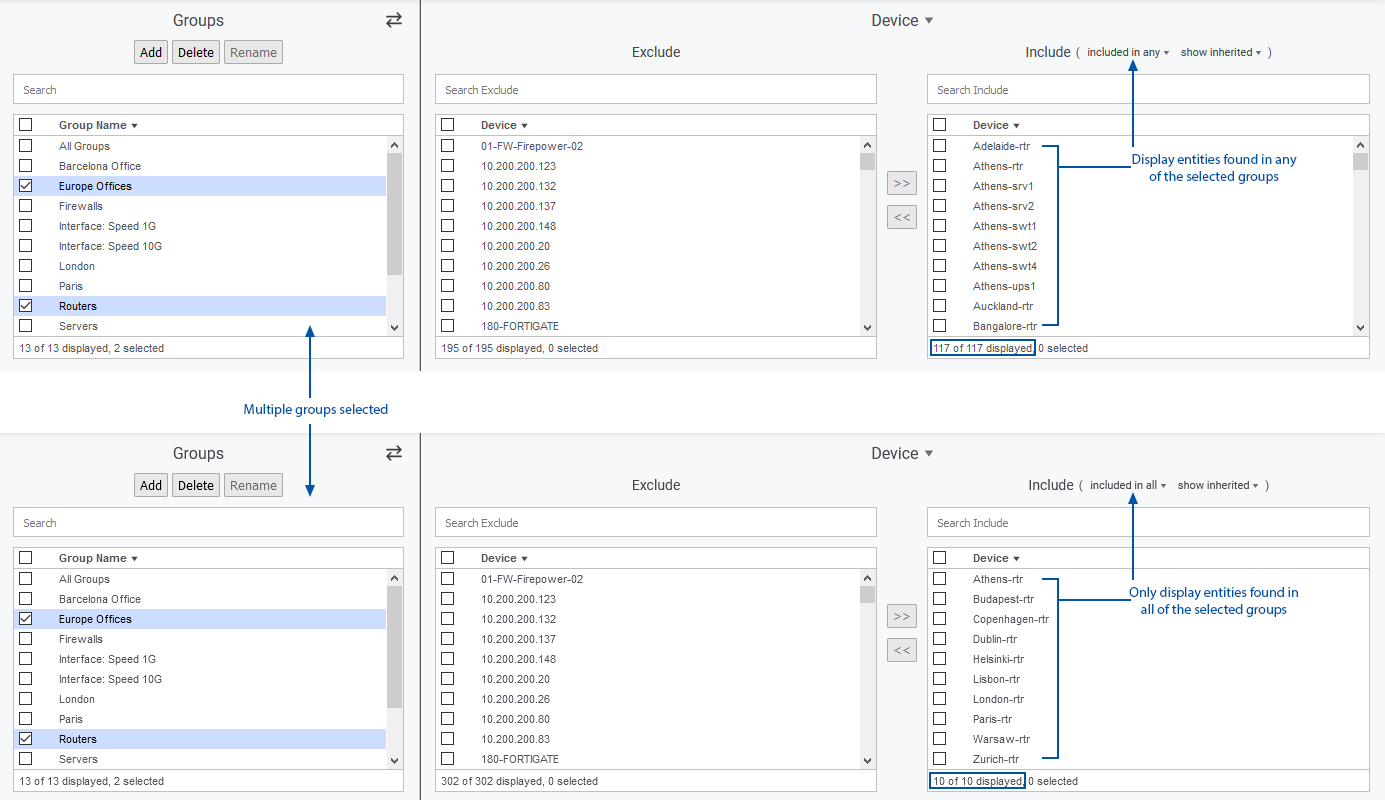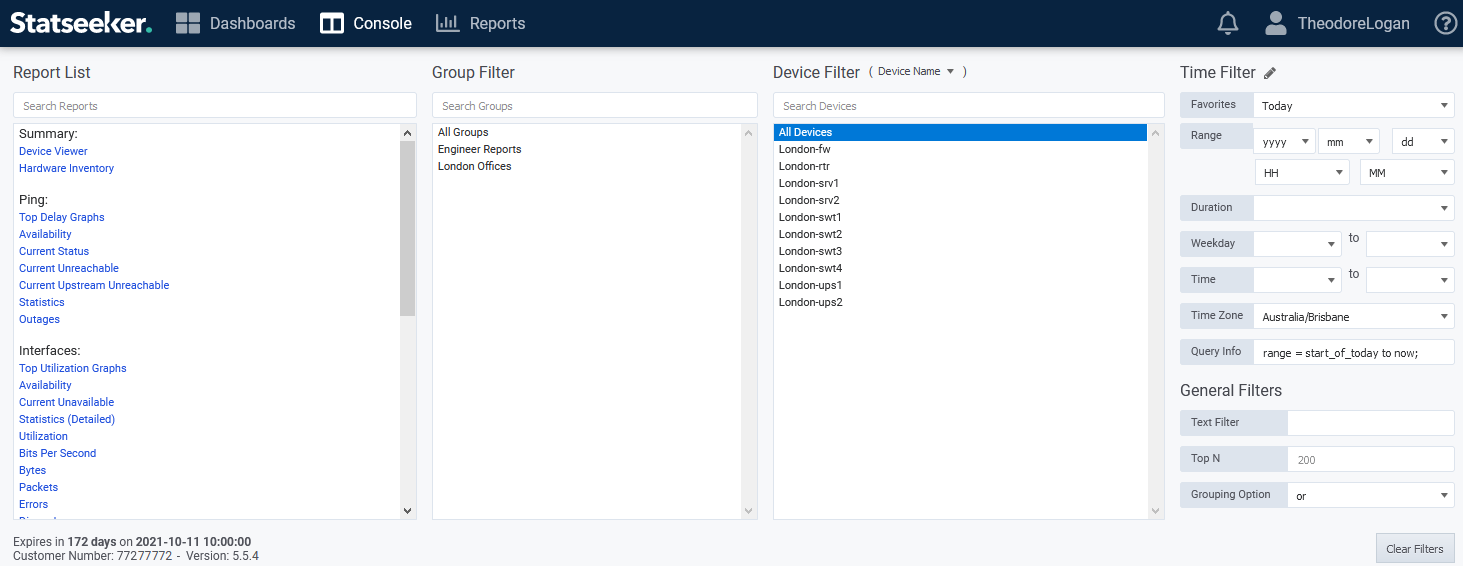Legacy Documentation for Statseeker version 5.5.4
Index
- Overview
- Manual Group Creation
- Renaming a Group
- Deleting Groups
- Manually Populating Groups
- Managing Users, and their Access with Grouping
- Grouping for SLA Reporting
Overview
Grouping is a fundamental feature in the Statseeker product, it is a core mechanic utilized by:
- Reporting
- Thresholds
- Alerting
- Visibility and access control
- Filtering response data when utilizing the API
While Automated Grouping is designed to handle the majority of your grouping requirements, manual grouping offers a very limited set of functionality that auto-grouping doesn't. Manual grouping is required for:
- Managing Statseeker user account's access and visibility to devices and reports
- Grouping non-infrastructure elements such as reports, users, and SLA configurations
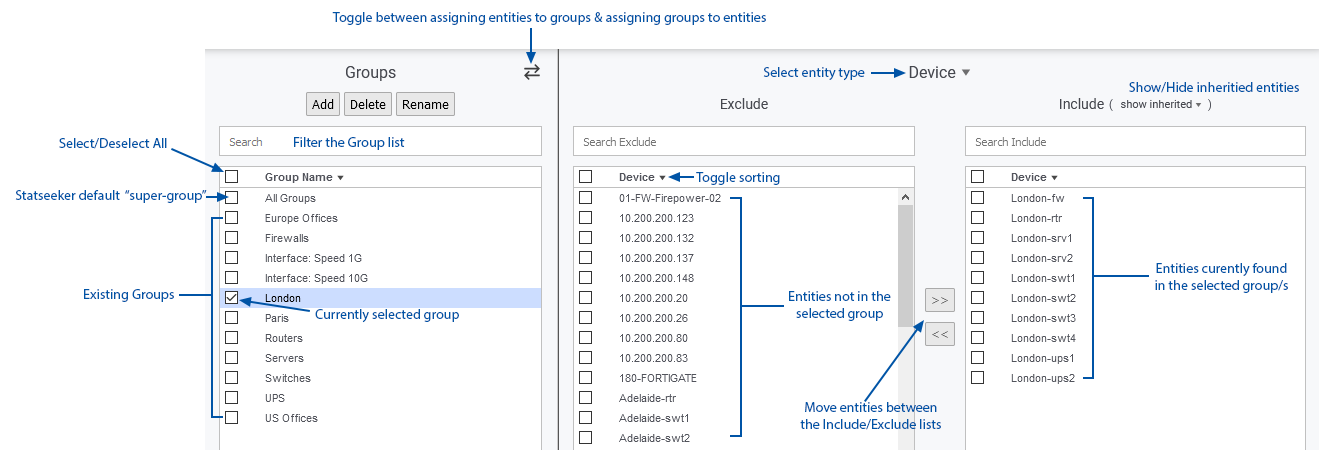
Manual Group Creation
In addition to those groups created by the Automatic Grouping process you can manually create and populate groups to suit your needs.
- Select Administration Tool > User Profile/Grouping > Add / Edit Groups
- Click Add
- Enter a name and click OK

The created group can now be populated with any number and type of entities.
Renaming a Group
To rename an existing group:
- Select Administration Tool > User Profile/Grouping > Add / Edit Groups
- Select the group and click Rename
- Update the name and click OK
- Custom Reports with filter configurations that reference the old group name will not find the group content and, as a result, may be missing the desired data
- If the renamed group is managed by an Auto Grouping rule, then unless the Auto Grouping rule is updated the old group will be recreated and populated on the next discovery/rewalk
Deleting Groups
To delete groups:
- Select Administration Tool > User Profile/Grouping > Add / Edit Groups
- Check the box to select one or more groups and click Delete
- Confirm the action to delete the group/s
Deleting groups does not impact the entities contained within the group/s outside of removing them from a deleted group.
- Custom Reports with filter configurations that reference the group will not find the group content and, as a result, may be missing the desired data
- If the deleted group is managed by an Auto Grouping rule, then unless the Auto Grouping rule is updated the old group will be recreated and populated on the next discovery/rewalk
Manually Populating Groups
All groups can have their contents edited manually from the Administration Tool. This can be achieved in two ways, adding entities (device, interface, report, user, etc.) to a group or selecting an entity, and selecting which groups will contain that entity.
Adding/Removing entities to/from a group
- Select Administration Tool > User Profile/Grouping > Add / Edit Groups
- Select one or more groups
The Exclude\Include columns will update to display the content of the group/s.

The entity type defaults to Device and the Exclude\Include column content is restricted to the selected entity type.
- Select the type of entity to be added to the group from the drop-down list above the Exclude\Include columns
- Select entities in the Exclude columns and click
 to add the entities to the group
to add the entities to the group - Select entities in the Include columns and click
 to remove the entities from the group
to remove the entities from the group
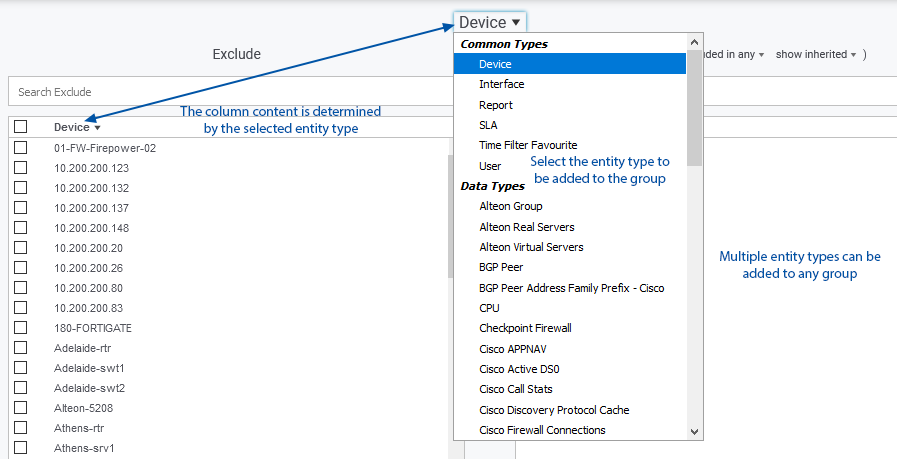
There is no confirmation, the group contents are updated immediately.
Selecting Multiple Groups
By selecting more than one group, multiple groups can be populated at a time using this method, the selected entities being added to each of the selected groups. When selecting multiple groups the Exclude\Include columns can be configured so that:
- Entities found an any of the selected groups are displayed in the Include column
- Only entities found in all of the selected groups are displayed in the Include column
Selecting groups to contain an entity
Grouping can be managed by starting with the entity (or entities) and then selecting groups that will contain the entity.
- Select Administration Tool > User Profile/Grouping > Add / Edit Groups
- Click the Entity\Group toggle (
 )
) - Select the entity type from the dropdown above the first column
- Select one or more entities
The Include/Exclude lists will update to indicate which groups currently contain the selected entity.
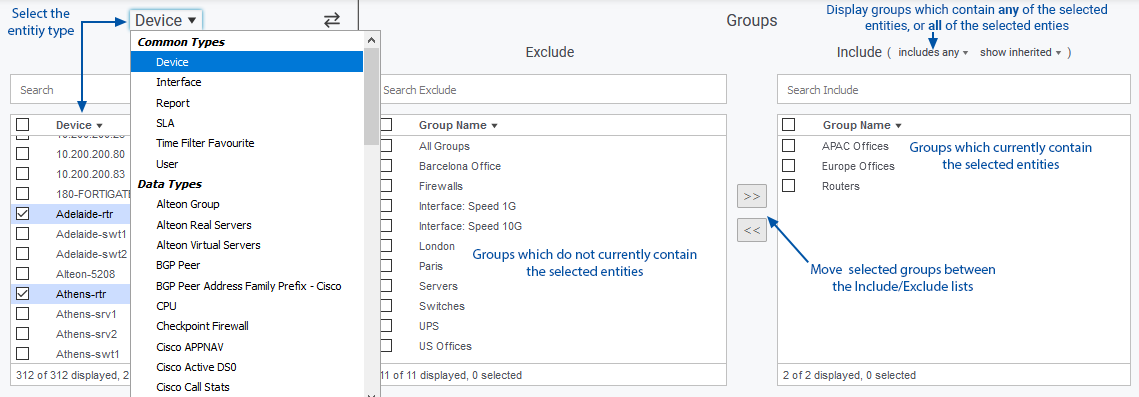
- Select entities in the Exclude columns and click
 to add the entities to the group, the group will move to the Include column
to add the entities to the group, the group will move to the Include column - Select entities in the Include columns and click
 to remove the entities from the group, the group will move to the Exclude column
to remove the entities from the group, the group will move to the Exclude column
There is no confirmation, the group contents are updated immediately.
Selecting Multiple Entities
When selecting multiple groups the Exclude\Include columns can be configured so that:
- Groups containing any of the selected entities are displayed in the Include column
- Only groups containing all of the selected entities are displayed in the Include column
When "includes any" is used, there is no indication which of the selected entities resides in which groups in the Include column.
- Adding a group to the Include column will add all selected entities to that group
- Removing a group from the Include column will remove any instance, of any of the selected entities, from the group
Inherited Entities
When adding devices to a group, the group also inherits all of the entities found on that device. These inherited entities include interfaces, CPU's, memory modules, temperature sensors, file systems, fans, etc. This inheritance works in a single direction only, from parent to child entity.
- Setting the entity type to device and adding a device to a group will add all interfaces on the device as inherited entities
- Setting the entity type to interface and explicitly adding an interface to a group does not also add the parent device to the group
Inherited entity visibility can be toggled by the option displayed above the Include column. Inherited entities are 'greyed-out' and cannot be selected or removed, to remove an inherited entity, remove the parent. Removing a parent entity from a group will also remove any associated inherited entities but does not remove any explicitly added child entities.
Show/Hide Inherited Entities
- Inherited entities (of the currently selected entity type) can be shown/hidden via the toggle located above the Include column
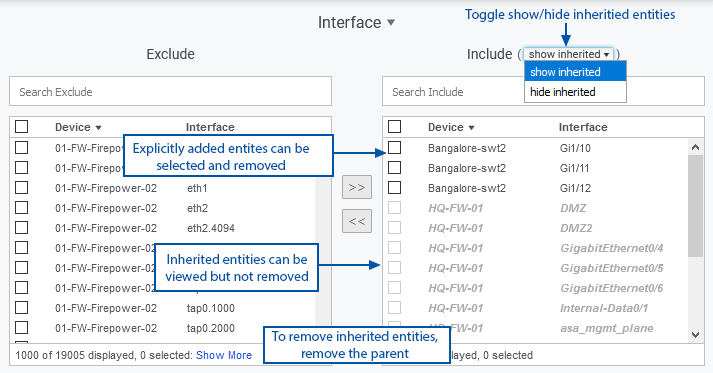
Managing Users, and their Access with Grouping
By default, a new Statseeker user account has no visibility of your network via Statseeker. To allow the user to use Statseeker, and view data collected from your network, you need to associate the user account with one or more groups. A group may be a subset of all devices on your network, or a group of other users or reports.
Reports can be built to be targeted at a specific device or group of devices or they can be configured to be network-wide reports. If a Statseeker user only has visibility to a subset of your network, viewing a network-wide report will instead show the report as if it was configured to target the subnet that they have responsibility for.
Example:
Our new user, Theodore, logs into the Statseeker server but has no visibility of any device or associated report.
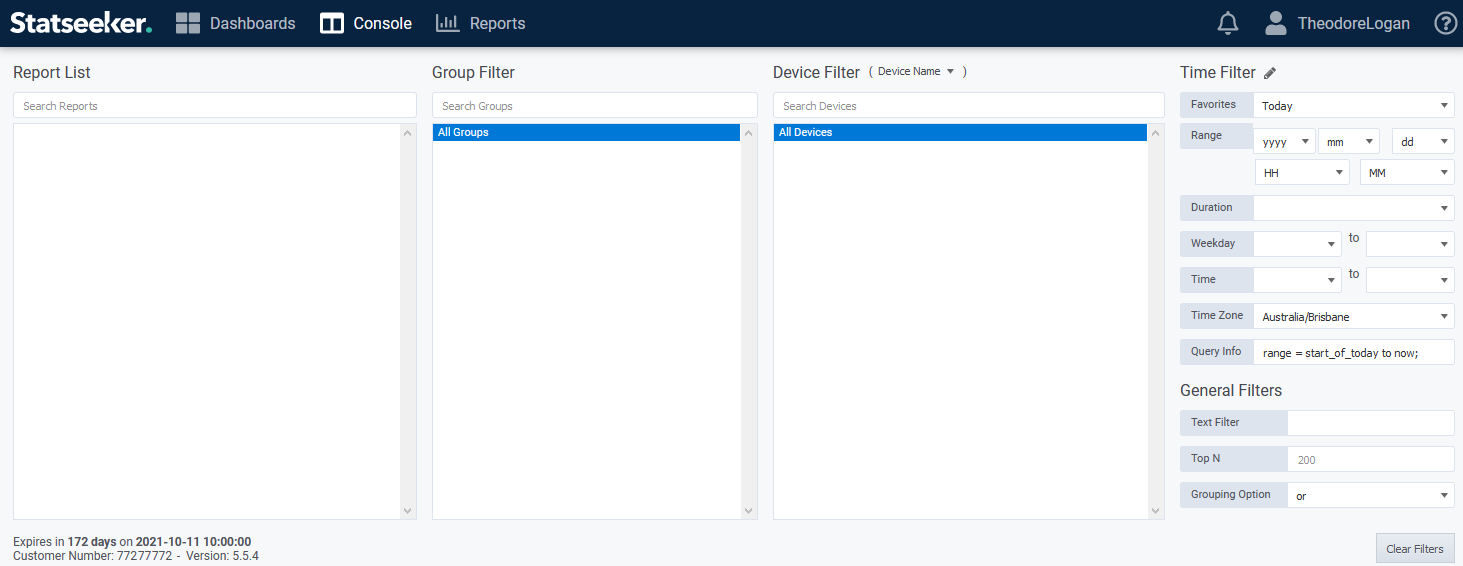
Theodore's user account needs to be associated with both devices and reports. We already have a group, London Offices, which contains the devices in the location that Theodore will be administering, but we need to also give Theodore access to reports. We could simply add reports to the London Offices group and give Theodore access to that group, but instead we are going to create a new group specifically for reports and all new network engineer accounts can be assigned that group when they join the organization.
We:
- Select Administration Tool > User Profile/Grouping > Add / Edit Groups
- Click Add and enter the group name Engineer Reports in the text field and click Ok
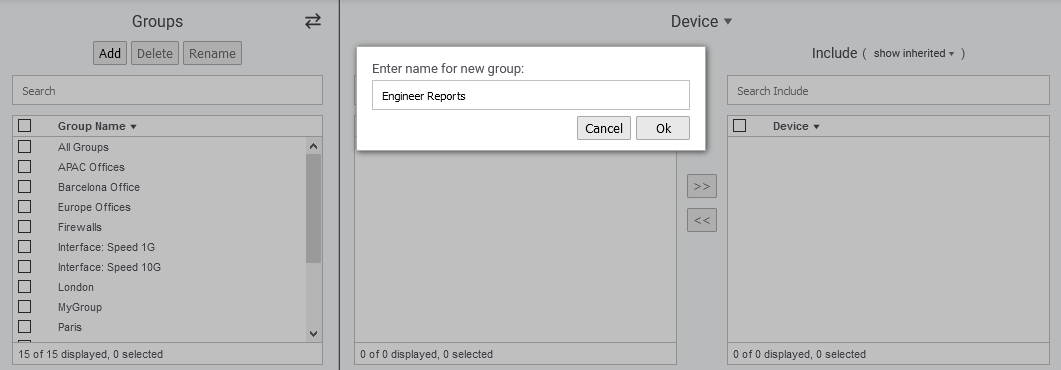
The group will be created and automatically selected, ready for population.
- Set the entity type to Report
- Assign a selection of reports to the group

- Click the Entity\Group toggle (
 )
) - Set entity type to Users
- Select Theodore from the list of users
- Select both the London Offices and Engineer Reports groups from the list and click
 to add the groups to the Include column
to add the groups to the Include column

Theodore refreshes his browser and can now see the devices and reports contained within the two groups that his user account has been associated with.
Grouping for SLA Reporting
Manual grouping is also a required component for SLA reporting. This topic is covered in detail in its own document, see Service Level Agreement (SLA) Reporting for details.

